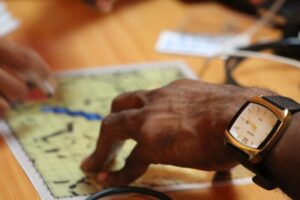West Africa remains one of the most biologically rich places on the planet, containing more than 9000 species of plants, a thousand species of butterflies, and is among the global hotspots for mammal diversity (CEPF, 2015). Other species follow suit to make these forest landscapes unique and irreplaceable. They are also in decline. Beset by histories of war, poverty, disease and landscape degradation, there is a palpable optimism in the Mano River Union region of West Africa that forest landscape restoration can provide people and nature with the means for sustainable livelihoods, and can support functioning landscapes for many generations to come.
Diecke/Mt. Nimba landscape in Yomou, Nzerekore, Guinea. Modified landscapes that include a mosaic of natural forests and human land uses (especially agriculture) are often a focus of restoration opportunity assessments. The intent is to use the best science and the best knowledge to improve landscape scale decision-making focused on nature-based solutions to challenges shared by many different sectors and people. Photo jbdodane
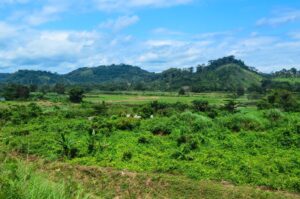
Monrovia, Liberia February 28, 2019.
Craig R. Beatty, IUCN Programme Officer, Global Forest and Climate Change Programme
Nestled amidst the bustling activity near Monrovia, a team of experts from Côte d’Ivoire, Guinea, Liberia and Sierra Leone gathered with IUCN and the Manu River Union (MRU) to begin the process of assessing the opportunities for forest landscape restoration (FLR). Over the coming months trained teams will implement the Restoration Opportunities Assessment Methodology (ROAM) in four transboundary landscapes. Liberia alone contains more that 43% of the remaining upper Guinean tropical rainforest, and within the boundaries of all four countries, which represent the members of the Manu River Union, is the Upper Guinean Forests biodiversity hotspot.
Still, there are persistent social, economic, and environmental challenges in the region including logging, mining and unsustainable subsistence activities that contribute to an ever-growing demand for natural resources. The increasing pressure on these vital landscapes contrasted with the associated benefits that these ecosystems can provide are of intense interest to the people living within them – as well as to national and international organizations who see the Mano River Union region as a global priority.
Stakeholders from each of the involved countries recently gathered together to increase their capacity on FLR, refine the objectives of restoration and identify the drivers of degradation in each of the four transboundary forest landscapes. These include the Gola forest landscape shared by Liberia and Sierra Leone. The Wonegizi/Ziama forest landscape shared by Guinea and Liberia, The Diecke/Nimba forest landscape shared by Guinea, Liberia and Côte d’Ivoire, and the Sapo/Grebo/Tai forest landscape shared by Liberia and Côte d’Ivoire. The engagement of these key stakeholders and the inception of the MRU ROAM is a critical component of a project implemented by IUCN and the Global Environmental Facility that will support ecosystem conservation and integrated water resources management using the FLR approach.
The ROAM assessments in these landscapes will provide an evidence-based and stakeholder-led assessment of where degradation is and how it is defined. It will then provide these landscapes and their decision-makers with a spatial analysis of where restoration could be best implemented and how the different types of restoration can work together to achieve the landscape objectives. In a transboundary context within the MRU, these assessments will provide a platform for the engagement of governments, businesses, communities, and other stakeholders to find nature-based solutions to landscape degradation that support improved ecology and human well-being. In this sense, the landscape assessments will contribute to a regional and transboundary forest landscape restoration strategy that can help address the needs of people and nature throughout this unique and dynamic region.
Figure 2: Richard SAMBOLA a project Consultant from Liberia works to identify the drivers of landscape degradation that result from unsustainable agricultural practices, forest loss, and biodiversity loss for the transboundary Diecke/Mount Nimba Landscape in Liberia, Guinea, and Cote d’Ivoire. Photo credit Craig Beatty/IUCN
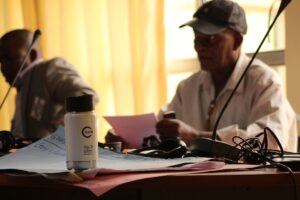
Olaimatu Sadia KARIM: National Coordinator, Sierra Leone (left), Solomon Peter GBANIE: Gola Landscape Consultant, Sierra Leone, and Daoda Socrates CARLON (right): Senior Technical Assistant for the National Executive Agency of Liberia, discuss how to prioritise forest landscape restoration to achieve biodiversity conservation, to improve livelihoods for forest-dependent people, and to improve ecosystem services within the transboundary Gola landscape between Sierra Leone and Liberia. Photo: Craig Beatty/IUCN
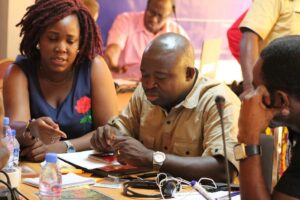
The Mano River Union facilities a regional administrative structure around which member states (Côte d’Ivoire, Guinea, Liberia, and Sierra Leone) can cooperate. Each of the landscapes straddles at least two countries and in the case of the Diecke/Nimba forest landscape, 3 countries must coordinate. In this respect there are many opportunities for learning and collaboration, but also many barriers, including language and sources of data and information for the assessment. Photo: Craig Beatty/IUCN
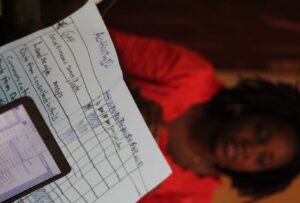
The Mano River Union is coordinating assessments of landscape restoration opportunity in four of the most biologically diverse forest landscapes in West Africa. Some significant and persistent threats to these forest landscapes include the expansion of subsistence agriculture, mining, hunting, and the loss of ecosystem services. In the following year, IUCN and national teams from Sierra Leone, Liberia, Guinea and Cote d’Ivoire will facilitate ROAM assessments in order develop nature-based solutions to these challenges at the landscape scale. Photo:Craig Beatty/IUCN
